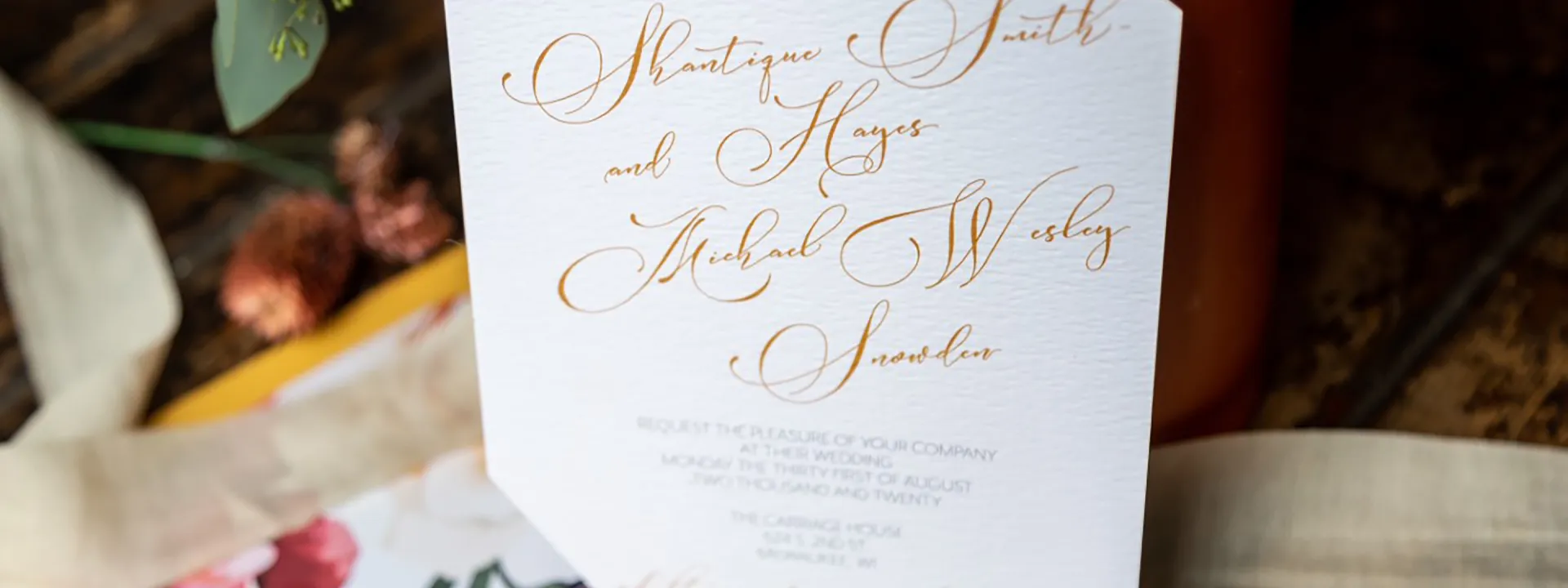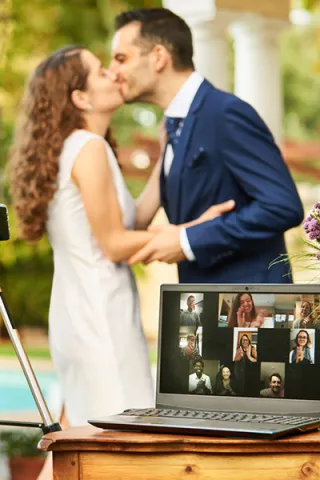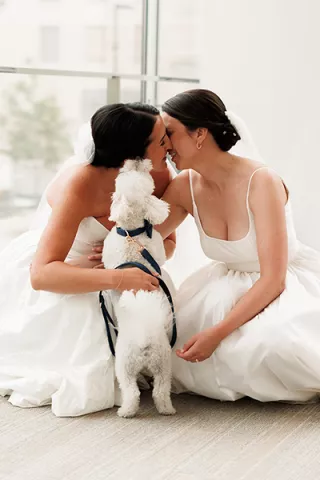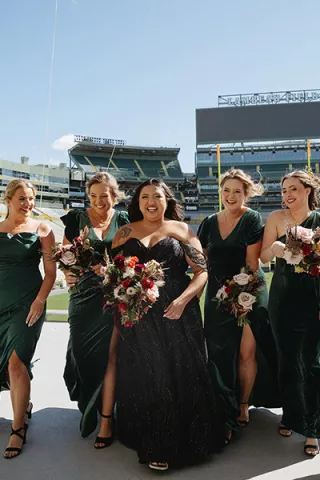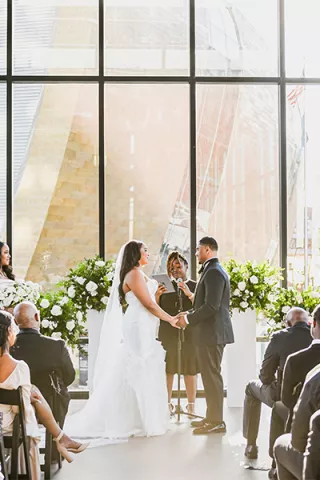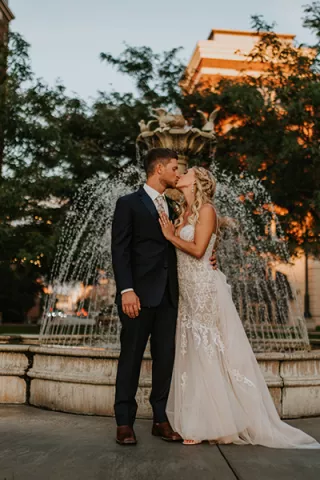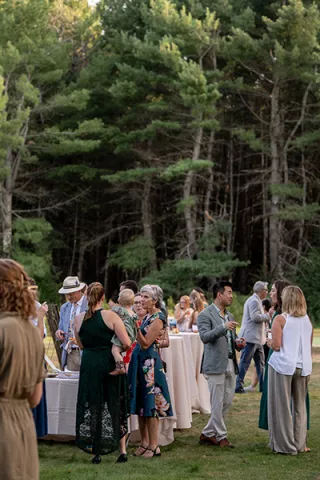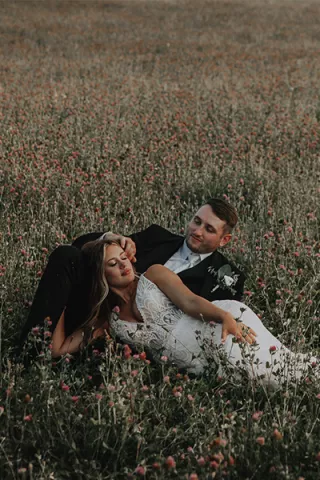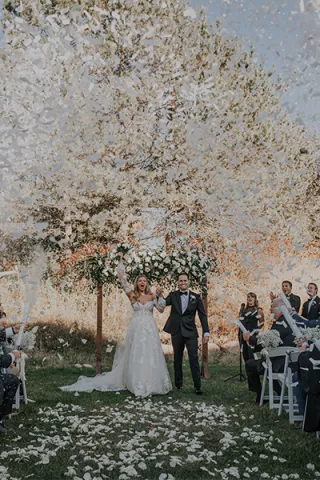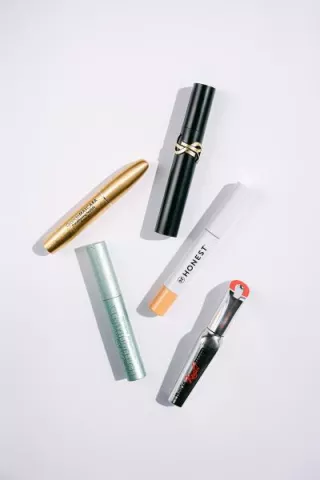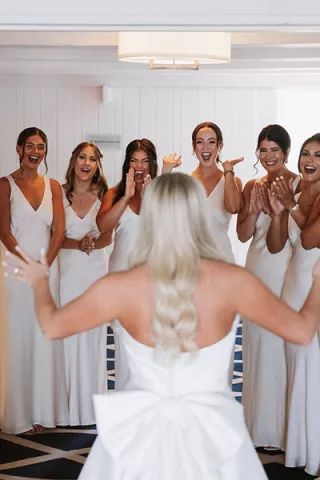Q: This is embarrassing, but I’m terrified of choosing a wedding gown. I don’t have the greatest figure—at least I don’t think I do—so shopping for the perfect dress is daunting. How will I ever find something that I like that I also think looks good on me?
A: Whether you’re a size 2 or 22, finding the perfect gown can be stressful. Brides-to-be can find themselves overwhelmed with too many—or too few—options. Stay positive and focus on finding the dress that helps you radiate confidence. “Self-love” might be an overused term, but it’s essential when you’re shopping for your wedding dress.
FIND INSPIRATION
Don’t worry if you’re not sure of the style you want; you’re not alone. Start with a list of everything you think you want in a gown, like lace details, low back, sweetheart neckline, etc. Look at gowns on Pinterest (or in Wisconsin Bride!) Once you’re ready to step into the shop, bring pictures so your stylist has an idea of what you like and think you want. That said, be open: Just because you don’t like the style in a photo doesn’t mean you won’t like it on yourself. Your stylist can show you things you might not even have thought of, explains Jennifer Kapinus at Vera’s House of Bridals (and granddaughter of Vera herself), and most brides surprise themselves with what they fall in love with.
SCOUTING EXPEDITION
Do a little recon, visiting various stores. Check out websites, social media and reviews to narrow down your list. Look for shops that have a variety of styles and price options, and a staff you like, trust and treat you like the VIP you are. While doing recon, ask about in-store sizing. “It’s not uncommon to find your dream gown without seeing it in exactly your size,” Kapinus says, “but you will still want to be able to try on gowns that fit well.” Discuss in advance the styles you like and make sure they have those in your size. And be aware that bridal gowns differ in sizes from designer to designer and fit differently than everyday clothing. “Try not to fixate on the size of the gown that you are in; a dress fitting well is so much more important than the number on the tag,” Kapinus advises.
BRING ON YOUR BESTIES
When you gather your group for the appointment, keep it light. Choose friends and/or family who make you feel your best—no negative energy allowed—but will also be honest and respect your decisions. And keep it a small, intimate group. You want opinions, but not too many.
PRE-APPOINTMENT
Before you walk through the shop doors, do your hair, makeup and anything else that makes you feel like your best self. Kapinus suggests wearing something you’re comfortable in and bringing undergarments and/or shapewear if you want. “Keep in mind your stylist will be helping you in and out of the gowns, so most brides wear nude underwear and a strapless bra,” she says. Hate strapless bras? No problem. Most bridal gowns have built-in bra cups for extra support.
BRING IT ON
Once at your appointment, remember to keep that positive energy flowing. If a gown doesn’t feel right, don’t get discouraged — there’s always another to try on. And remember, the person you’re marrying already thinks you’re beautiful; what you wear should just help you feel even more so, all the way down the aisle.
Q: We’ve barely gotten engaged, and already people are telling me I have to start sending out announcements! What’s the protocol for announcements and invitations?
A: You want your stationery to be as unique as your relationship, to reflect who you are as a couple, so finding the right designer or graphic artist early is a must. Once you choose your designer, they can advise you on the ins and outs, but here are some general guidelines.
SAVE-THE-DATES
Order 10-12 months before the wedding; send 6-12 months before
These will be hanging on your guests’ fridges for a while, so make sure you love them. The cards should include you and your partner’s names, the wedding date or weekend, and a location. If you have yet to pick a venue, add the city or town. A save-the-date card can also say “formal invitation to follow,” to give guests a heads up. Some couples just go with text and a design, while others use an engagement photo.
Star McMurtry, owner of Taylor Design & Stationery in Franklin, suggests adding an extra two months for sending destination wedding save-the-dates. This gives guests time to clear their calendars and make travel plans. “It also gives them something to look forward to—the wedding invitation!” she notes.
ENGAGEMENT PARTY INVITES
Send 4 weeks before the party
Engagement parties can be a nice prequel for guests to meet before the big day. Some couples have a get-together right after the proposal, others wait up to three months post-engagement, so work backward to figure out when to finalize your design.
WEDDING INVITATIONS
Finalize design: 5-8 months before; send 2 months before
This is the go-to information card for your guests. A traditional invite includes a host line, usually the couple’s parents. Then comes the request line where you ask your guests to attend; next come the couple’s names, followed by the date, time, and ceremony and reception location(s). There are endless wording options; if in doubt, ask your stationer.
McMurtry says for local weddings, couples should be discussing design concepts with their designer and placing orders five to six months before their wedding day. For destination weddings, couples can begin as early as eight months before, no later than six months. Many couples like to match the invitation suite to their wedding palette for a cohesive look, but Debbie Pape of Paper Envy in Elm Grove says working with your stationer early not only allows you to get exactly what you want but also helps you figure out what other details still need to be discussed and gathered, such as guest accommodations.
Make sure you add an RSVP deadline so you can get the final guest count to your venue on time. (It’s also fun to see who is coming so you can play match-maker with your single friends.)
DAY-OF STATIONERY
Finalize design: 2-3 months before
Your guests will be eyeing the day- of stationery all day (and night)— place cards, seating charts, signs, menus, program, favors, etc.
Two to three months before the wedding is a great time to sit down with your stationer, since, as Pape notes, other wedding elements come into play. For example, your stationer will need dinner choices for the response card and/or menu, so plan your tasting dates accordingly.
“It’s OK if you don’t have all this information when you first sit down with the stationer,” Pape says. “It’s a process that we work together on, and it’s typically a super-fun experience.”
Q: My fiancé and I have been talking about whether I’ll take his last name or keep my own. I’m so conflicted! Could I ask him to take my last name, or is that just not a thing?
A: Taking the last name of your spouse is a tradition you don’t have to follow. In the olden days, it signified that the wife was “transferred” from her family’s property to the husband’s. Today, marriage is about two people who love each other, name change or not, so switch it up if you want. Our wedding professionals offer a few ideas.
IF IT AIN’T BROKE
A lot of brides keep their name because it’s the zero-hassle option—no need to change social media, business cards or legal documents—and it’s certainly not unheard-of these days.
ASK YOUR SPOUSE TO TAKE YOUR LAST NAME
This option offers a shared name as a couple. “You may feel uncomfortable changing your last name, but your partner may feel less attached to theirs,” says Genesis Lopez of Ambrosia Events. “Have a conversation with your partner about their feelings on taking your last name.”
HYPHENATE
Hyphens can work wonders. A small dash between you and your spouse’s last name is the perfect way to recognize both families—even better if the names sound great together. Remember, though, if kids are in your future: Will the name be awkward to pronounce? Will it create challenges if they marry someone with a hyphenated name?
MERGE OR CREATE A NEW ONE
Merging your last names together can be a fun way to make something brand-new for the both of you. “It’s a great way to represent unity and the start of a new life together,” Lopez says. Or simply invent something new. “Not only are you passing on your new last name,” says Meredith Sipe, CEO and owner of Blue Fancy Events, “but you’re passing on a pretty cool story for your future children and grandchildren.”
KEEP YOUR NAME PUBLICLY
This is a great option for all you professionals out there. Legally, you take your spouse’s last name, but continue to use your unmarried name in work situations (for example, if you’re a magazine writer).
MAKE YOUR LAST NAME YOUR MIDDLE NAME
If you’re planning on having kids, this is a great way to keep the name in the family.
Whatever you decide, do it confidently—there’s no right or wrong answer.
